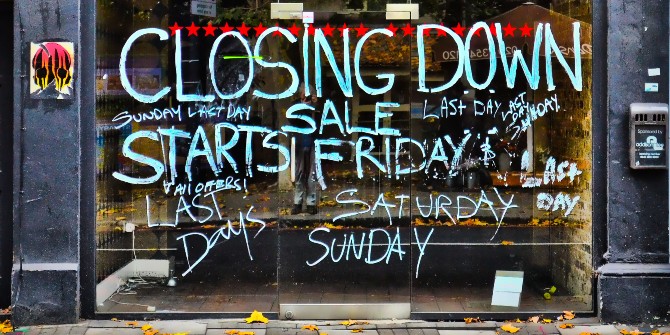Bankruptcies are costly, but economists worry about keeping doomed firms alive. Simeon Djankov (LSE) argues that restructuring bankruptcy laws has given companies breathing space to adapt and recover from the economic shock of COVID.
Companies suffering losses struggle to survive, and many fail. Many expected a wave of bankruptcy filings during the pandemic. Yet during 2020, the number of corporate filings in most advanced economies (members of the OECD) fell by 21% compared to 2019, and by even more relative to previous years (Figure 1). In early 2021, they fell further to less than 70% of their 2019 level.
Figure 1: Annual bankruptcy filings in 24 advanced economies

Sources: Statistics Sweden for Sweden, Bank of France for France, ASIC for Australia, U.S. Courts for the US, and National Statistics retrieved from Macrobond (August 27, 2021) for all others. The index is based on the latest available data (most often January to June 2021) is annualised to 2021 annual aggregates.
In the EU, Austria is experiencing the largest decline, with bankruptcy cases dropping by 76% from 2019 to 2021. The Netherlands and France follow, with around a 50% decline by 2021.
Why changing bankruptcy laws works
This decline in bankruptcies demonstrates the success of the initial COVID response measures. Nonetheless, it can also be concerning. Some economists worry that keeping insolvent firms alive will drain resources from the healthy parts of the economy. The changes in bankruptcy law in some OECD economies are one part of a larger package of recovery measures designed to address this concern. Previous experience (during the East Asian financial crisis, for example) shows that such legal changes take time to percolate to insolvent firms. The longer delay in the wave of bankruptcy filings helps these firms.

Crisis or not, giving firms the opportunity to propose a restructuring plan outside of the formal judicial process is good for the economy. This is because as much as 30 percent of the company value is lost in bankruptcy procedures in high-income countries when the business is liquidated or sold piecemeal. This loss can be avoided altogether or at least attenuated when governments introduce restructuring plan features in their laws.
In the aftermath of the pandemic, bankruptcy laws have been revised in seven OECD economies (Australia, Belgium, Germany, Hungary, the Netherlands, Singapore, and the UK). Three changes in particular have become common during the pandemic. The first enabled an illiquid company to reach an agreement with its creditors with no involvement from the courts. Second, distressed companies are given greater latitude to force a restructuring agreement on every creditor if the majority of creditors agree. And third, suppliers are prevented from stopping deliveries on the ground when the debtor is having trouble paying creditors, as long as the debtor firm pays for its supplies on time—even putting them ahead of bank creditors.
In addition, government moratoria on bankruptcy filings have been extended several times. Nearly two-thirds (23 out of 38) of OECD economies introduced temporary debt payment moratoria in response to the pandemic. For example, France made several temporary amendments to French bankruptcy law in May 2020, including the suspension of insolvency filing duty, extension of the length of the conciliation procedure, and the opportunity for management to adopt safeguard and restructuring plans. Some of the measures, such as protections for debtors in conciliation, were extended to the end of 2021.
Opportunities to pivot and adapt
In jurisdictions whose bankruptcy laws already had reorganisation options available, or in countries like Germany and the Netherlands that used the pandemic as an opportunity to update their insolvency regimes, the fear of insolvent firms dragging down the economic recovery seems unfounded. Recovery may instead take the form of cross-sectoral shifts in employment and productivity, as consumer preferences have evolved due to the pandemic and global supply chains have become more local, providing opportunities for new growth in Europe.
This post represents the views of the author and not those of the COVID-19 blog, nor LSE.





